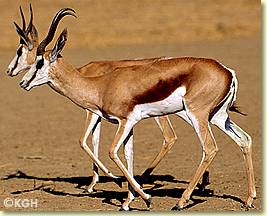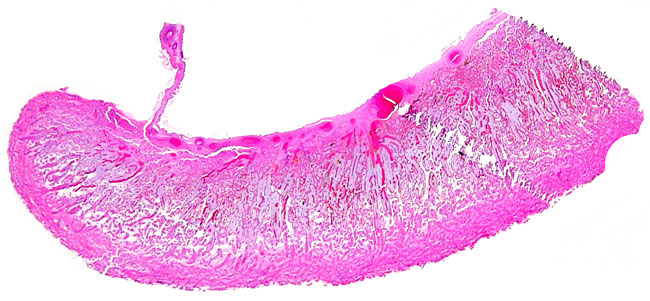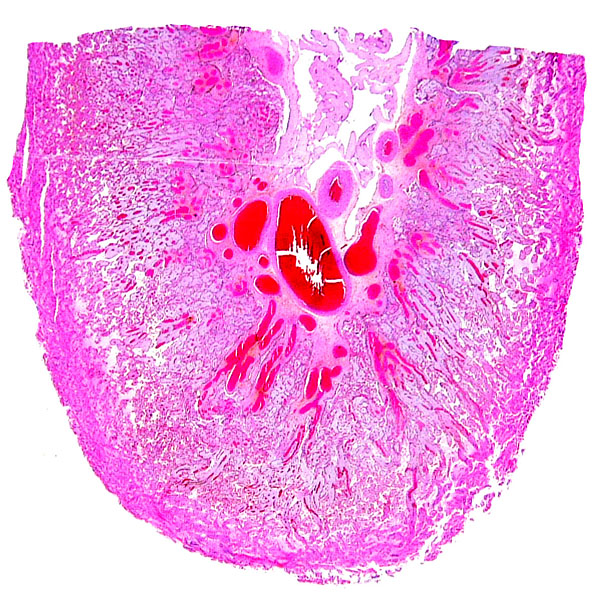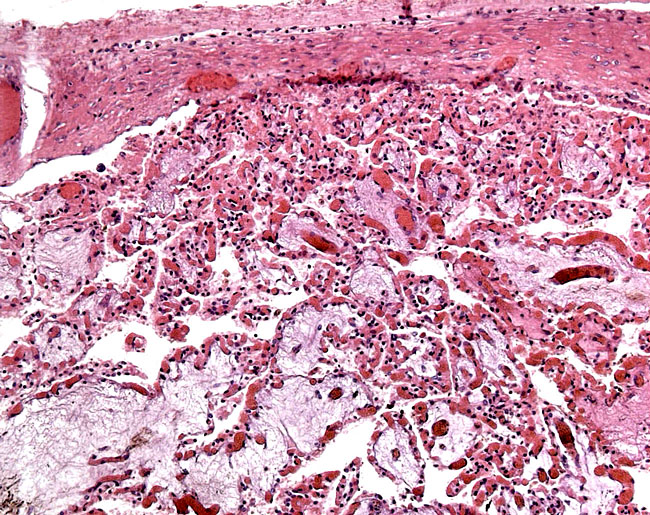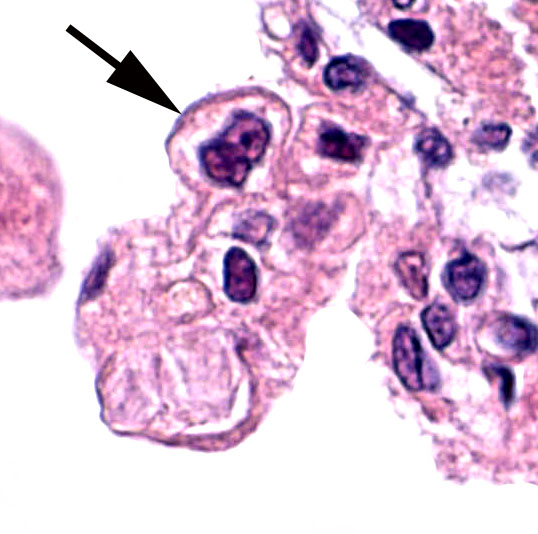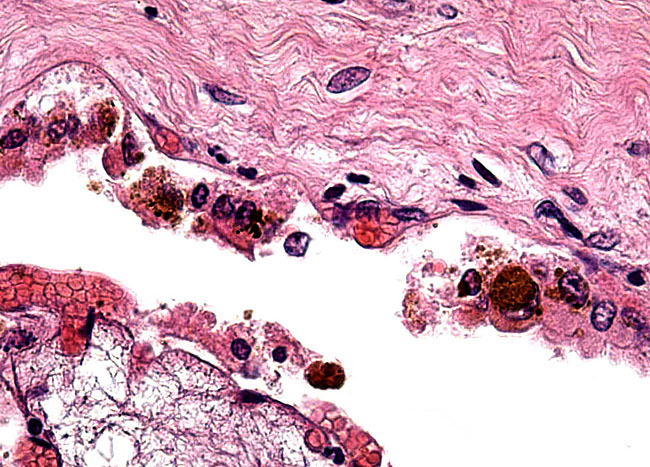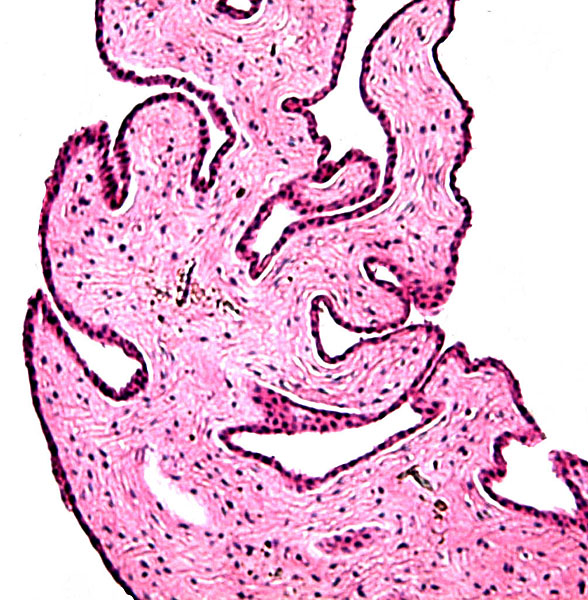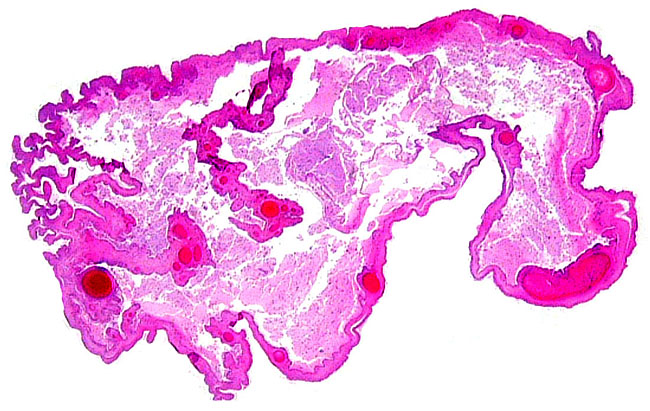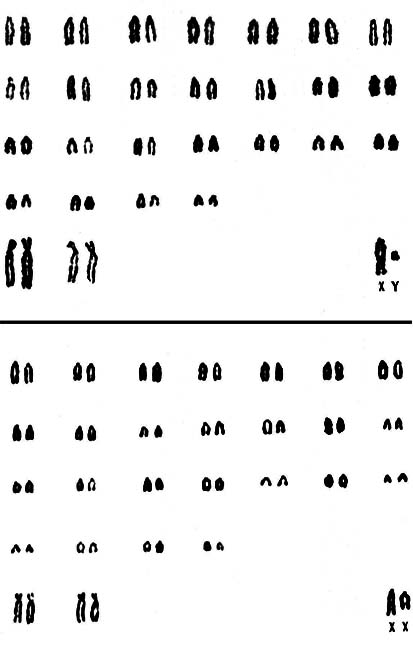|
14) Immunology
I know of no relevant studies.
15) Pathological features
Iverson et al. (1982) reported that around 18% of a captive herd of springbok died within 2 weeks of birth from polycystic renal disease which was combined with cystic dilatation of the bile ducts. They inferred an autosomal recessive disorder and suggested this to be a valuable experimental animal. Skinner (1971) reported a bilaterally cryptorchid ram. Numerous parasites have afflicted the springbok. Thus, Boomker et al. (2000) recorded various helminths; Horak et al. (1992) found only few ticks in springbok surveyed 48 springbok and identified several worms, and Horak et al. (1982) isolated helminthes, ixodid ticks and various lice from springbok. Later (Horak et al., 1991) again isolated ticks and several worms. Chlamydiosis was diagnosed in a young springbok on a farm with many neonatal deaths (v.d. Lugt & Kriek, 1988). Griner (1983) found coccidiosis in a springbok and discussed the 20% perinatal mortality of the San Diego Zoo.
In February 2009 we saw an abnormal pregnancy that raises several interesting points: This gestation was in the first trimester and terminated after the dam had been gored three days earlier and thus lost the ability to use the right hind limb. The springbok presumably became septic and the lymph nodes were hugely enlarged. The fetus was severely edematous, recently dead and the placenta had markedly abnormal features.
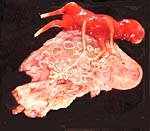 |
This opened uterus shows the edematous fetus and peripheral cotyledonary calcifications. |
| |
|
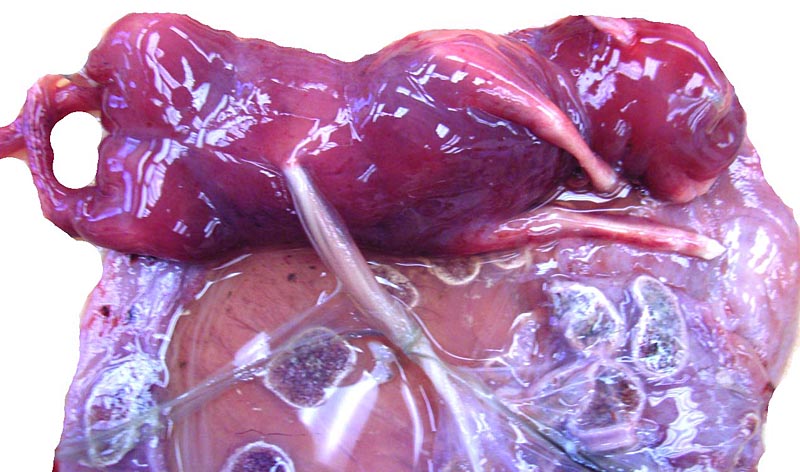 |
The edematous and hemorrhagic fetus with short umbilical cord.
|
| |
|
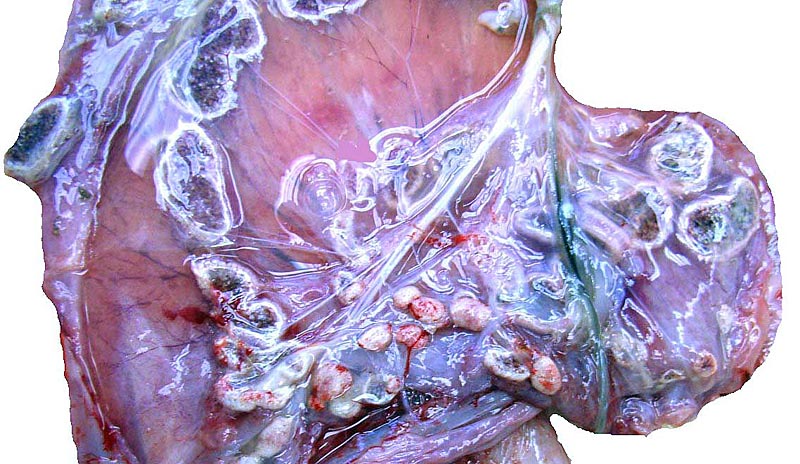 |
This photograph shows the peripheral calcium deposits at the edges of cotyledons. |
The female fetus weighed 237 g, was 17 cm long in CR length and had a 6 cm umbilical cord. The fetus and placenta were confined to the left uterine horn, and approximately 50 cotyledons were identified (aside from numerous tiny possible future cotyledons). Remarkably, there was a white (apparently calcific) rim around each cotyledon. Microscopically, the unusual feature is that the placental villous tissue was very well preserved (albeit somewhat edematous) and that the calcifications were totally confined to the chorionic membrane.
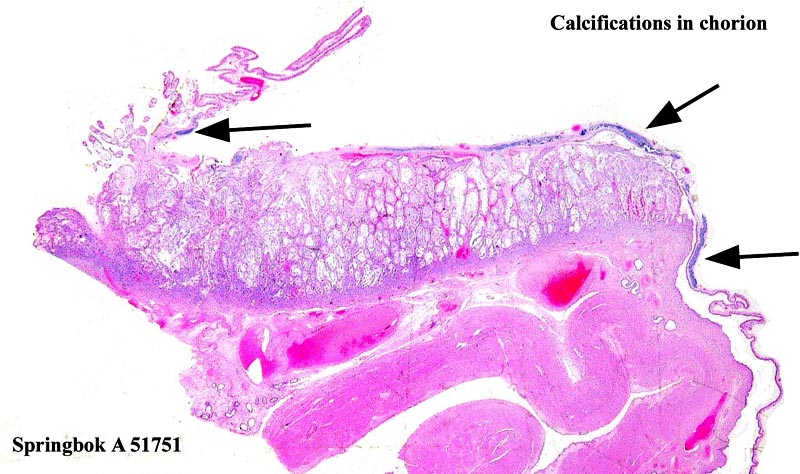 |
One implanted cotyledon with calcified regions confined to the chorionic membrane. |
| |
|
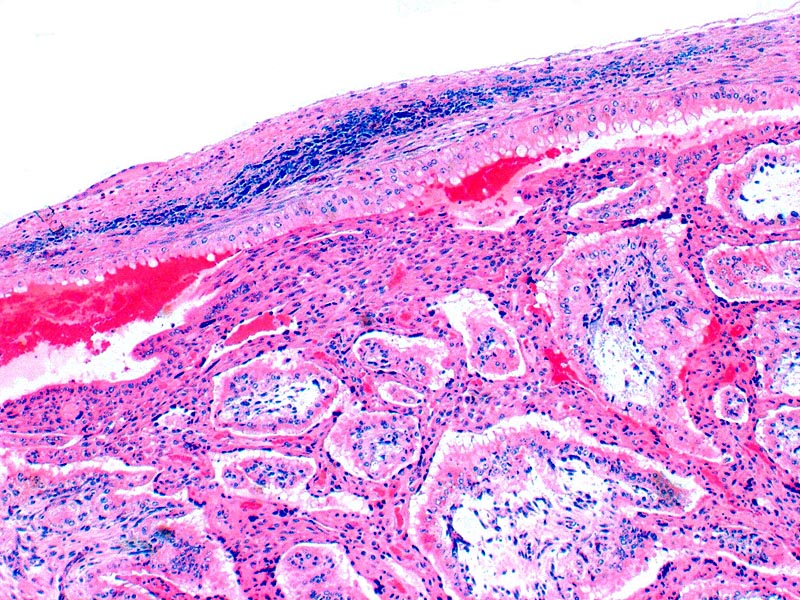 |
The villous tissue is well preserved but the chorionic membrane has deposits of calcifications. |
It is highly unlikely that the areas of calcification were causally linked to either fetal demise or its hydrops when the villous tissue was so normal in appearance. True, there was debris in the villous capillaries, but the surface fetal blood vessels contained live blood and they were not involved in the calcifications. There was none of the subchorionic pigmentation but many trophoblast cells had pigmented cytoplasm. In addition, there was no inflammatory reaction anywhere, the endocervix had mucus-secreting glands and the presence of Barr bodies ruled out X-monosomy.
16) Physiologic data
Jacobson (1983) provided data on immobilization (ketamine) and serum/hematologic values as well. Van Rijswijk & Vorster (1995) presented their findings of a study on adrenal mass and zonation of male and female springbok during different periods of the year. Males have larger adrenals and the “stress” of the dry season apparently enlarges the glands and widens the zona fasciculata. Blood and brain temperatures were studied by Mitchell et al. (1997) in free-living springbok during the hot day and cold night. Milk composition was studied by v. Zyl & Wehmeyer (1970).
17) Other resources
Several strains of fibroblast are available from CRES at the San Diego Zoo by contacting Dr. Oliver Ryder at oryder@ucsd.edu .
18) Other remarks – What additional Information is needed?
Early stages of placentation are not accessible to me; an implanted placenta and data on the length of the umbilical cord would be useful to have. The recent experience with an implanted placenta, measurements of cord and earlier development were added under pathologic features.
Acknowledgement
The animal photograph in this chapter comes from the South African Online Travel Guide.
References
Blaine, G.: Notes on the zebras and some antelopes of Angola . Proceed. Zool. Soc. London 22: 317-339 (plus plates), 1922.
Boetticher, H.v.: Gedanken über eine natürliche systematische Gruppierung der Gazellen (Gazellae). Z. Säugetierk. 17:83-92, 1953.
Boomker, J., Horak, I.G., Watermeyer, R. and Booyse, D.G.: Parasites of South African wildlife. XVI. Helminths of some antelope species from the Eastern and Western Cape Provinces . Onderstepoort J. Vet. Res. 67:31-41, 2000.
Dittrich, L.: Beitrag zur Fortpflanzungsbiologie afrikanischer Antilopen im Zoologischen Garten. Zool. Garten 39:16-40, 1970.
Els, D.A.: The anatomy of the female reproductive tract of the springbok (Antidorcas marsupialis). J. S. Afr. Vet. Ass. 52:29-32, 1981.
Els, D.A.: Ovarian morphology of the springbok, Antidorcas marsupialis . J. S. Afr. Vet. Ass. 54:119-121, 1983.
Gotch, A.F.: Mammals – Their Latin Names Explained. Blandford Press, Poole , Dorset , 1979.
Griner, L.A. : Pathology of Zoo Animals. Zoological Society of San Diego , San Diego , California , 1983.
Hayssen, V., van Tienhoven, A. and van Tienhoven, A.: Asdell's Patterns of Mammalian Reproduction: a Compendium of Species-specific Data. Comstock/Cornell University Press, Ithaca , 1993.
Herrick, J.R., Bartels, P. and Krisher, R.L.: Post-thaw evaluation of in vitro function of epididymal spermatozoa from four species of free-ranging African bovids. Biol. Reprod. 19.May, 2004.
Horak, I.G., Meltzer, D.G. and de Vos, V.: Helminth and arthropod parasites of springbok, Antidorcas marsupialis , in the Transvaal and Western Cape Province . Onderstepoort J. Vet. Res. 49:7-10, 1982.
Horak, I.G., Fourie, L.J., Novellie, P.A. and Williams, E.J.: Parasites of domestic and wild animals in South Africa . XXVI. The mosaic of ixodid tick infestations on birds and mammals in the Mountain Zebra National Park . Onderstepoort J. Vet. Res. 58:125-136, 1991.
Horak, I.G., Anthonissen, M., Krecek, R.C. and Boomker, J.: Arthropod parasites of springbok, gemsbok, kudus, giraffes and Burchell's and Hartmann's zebras in the Etosha and Hardap Nature Reserves, Namibia . Onderstepoort J. Vet. Res. 59:253-257, 1992.
Hsu, T.C. and Benirschke, K.: An Atlas of Mammalian Chromosomes. Vol. 2, Folio 89, 1968.
Iverson, W.O., Fetterman, G.H., Jacobson, E.R., Olsen, J.H., Senior, D.F. and Schobert, E.E.: Polycystic kidney and liver disease in springbok: I. Morphology of the lesion. Kidney Int. 22:146-155, 1982.
Jacobson, E.R.: Hematologic and serum chemical effects of a ketamine/xylazine combination when used for immobilizing springbok. J. Amer. Vet. Med. Assoc. 183:1260-1262, 1983.
Jones, D.M.: Ungulate status in the wild and in captivity. Intern. Zoo News 28(2):10-27, 1981.
Jones, M.L.: Longevity of ungulates in captivity. Intern. Zoo Yearbk. 32:159-169, 1993.
Lugt, J.J v.d. and Kriek, J.C.: Chlamydiosis in a springbok (Antidorcas marsupialis) J. S. Afr. Vet. Assoc. 59:33-37, 1988.
Mentis, M.T.: A review of some life history features of the large herbivores of Africa . The Lammergeyer16:1-89, 1972.
Mitchell, D., Maloney, S.K., Laburn, H.P., Knight, M.H., Kuhnen, G. and Jessen, C.: Activity, blood temperature and brain temperature of free-ranging springbok. J. Comp. Physiol. B 167:335-343, 1997.
Osterhoff, D.R., Schoeman, S.M. and Conroy, A.: Biochemical polymorphisms in the South African springbok (Antidorcas marsupialis). J. S. Afr. Vet. Ass. 53:37-39, 1982.
Rijswijk , A.W.v. and Vorster, F.: The influence of stress on the adrenals of the springbok (Antidorcas marsupialis). J. S. Afr. Vet. Ass. 66:251-253, 1995.
Robinson,T.J. and Skinner, J.D.: A karyological survey of springbok species. South Afr. J. Sci. 147-148, 1976.
Robinson, J.E., Skinner, D.C., Skinner, J.D. and Haupt, M.A.: Distribution and morphology of luteinising hormone-releasing hormone neurons in a species of wild antelope, the springbok (Antidorcas marsupialis). J. Comp. Neurol. 389:44-452, 1997.
Skinner, J.D.: A bilaterally cryptorchid springbok ram, Antidorcas marsupialis marsupialis. J. Reprod. Fertil. 26:377-378, 1971.
Skinner, J.D. and Zyl, J.H.M.v.: A study of growth of springbok ewes. Afr. Wildl. 24:149-154, 1970.
Skinner, D.C., Richter, T.A., Malpaux, B. and Skinner, J.D.: Annual ovarian cycles in an aseasonal breeder, the springbok (Antidorcas marsupialis) Biol. Reprod. 64:1176-1182, 2001.
Skinner, D.C., Cilliers , S.D. and Skinner, J.D.: Effect of ram introduction on the oestrous cycle of springbok (Antidorcas marsupialis). Reproduction 124:509-513, 2002.
Vassart, M., Séguéla, and Hayes, H.: Chromosomal evolution in gazelles. J. Hered. 86:216-227, 1995.
Villiers, I.L. de, Liversidge, R. and Reinecke, R.K.: Arthropods and helminthes in springbok (Antidorcas marsupialis) at Benfontein, Kimberley . Onderstepoort J. Vet. Res. 52:1-11, 1985.
Wurster, D.H. and Benirschke, K.: Chromosome studies in some deer, the springbok, and the pronghorn, with notes on the placentation in deer. Cytologia 32:273-285, 1967.
Wurster, D.H. and Benirschke, K.: Chromosome studies in the superfamily Bovoidea. Chromosoma 25:152-171, 1968.
Zyl, J.H.M.v.: Embryonic implantation in the springbok (Antidorcas marsupialis marsupialis (Zimmermann) and ovulation in the S. A. buffalo (Syncerus caffer caffer Sparman) Fauna and Flora (Pretoria) 28:17, 1966.
Zyl, J.H.M.v. and Skinner, J.D.: Growth and development of the springbok foetus. Afr. Wildl. 24:309-316, 1970.
Zyl, J.H.M.v. and Wehmeyer, A.S.: The composition of the milk of springbok (Antidorcas marsupialis), eland (Taurotragus oryx) and black wildebeest (Connochaetes gnou). Zool. Afr. 5:131-133, 1970.
|
